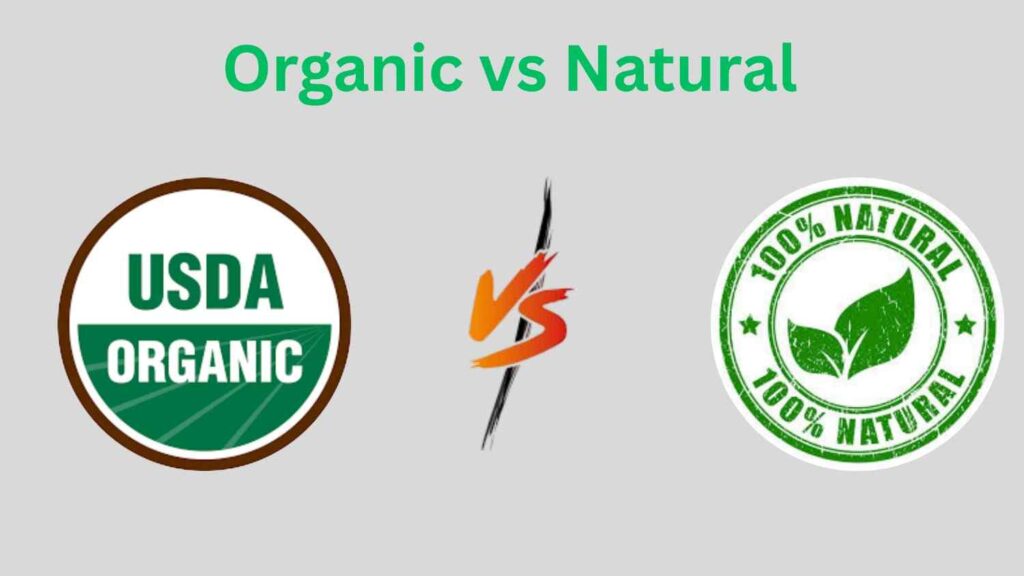Walking down a grocery store aisle can feel like solving a puzzle. Labels jump out at you—“organic,” “natural,” “all-natural”—and it’s easy to think they all mean the same thing.
But here’s the truth: when it comes to Organic vs. Natural, they are not the same at all. In the U.S., “organic” comes with strict government rules and certifications, while “natural” is more of a loosely used marketing term. Let’s break down Organic vs. Natural in a simple, easy way so you can shop with confidence.

What Does “Organic” Mean?
Think of “organic” as a seal of trust.
In the United States, the word organic is legally defined and heavily regulated by the USDA (United States Department of Agriculture). This means farmers and food companies have to follow strict rules if they want to use the USDA Organic Seal on their products.
Some important rules for organic foods:
- No synthetic pesticides, fertilizers, or herbicides (with very few exceptions).
- No genetically modified organisms (GMOs).
- Organic animals must eat organic feed, can’t be given antibiotics or hormones, and must have outdoor access.
- The land used for crops must be chemical-free for at least three years before it can be labeled organic.
Every farm or company that wants to be certified organic must go through inspections—sometimes even surprise visits. That’s why when you see the USDA Organic Seal, you know the food has been checked and approved from start to finish.
What Does “Natural” Mean?
Now here’s where it gets tricky.
The word “natural” sounds nice, but in the U.S., it’s not a legally defined label—at least not for most foods. The FDA (Food and Drug Administration) does not have strict rules for it. Generally, the FDA only says “natural” means the product doesn’t contain artificial colors, flavors, or synthetic ingredients.
But here’s what “natural” doesn’t guarantee:
- It doesn’t mean the food is organic.
- It doesn’t mean no pesticides or GMOs were used.
- It doesn’t tell you anything about how the food was grown or how the animals were raised.
There’s one exception: the USDA does define “natural” for meat, poultry, and eggs. If it says “natural,” it must be minimally processed and have no artificial colors or ingredients. But again—that doesn’t mean the animals were raised without antibiotics or growth hormones.
So when you see “natural” on a label, take it as a very light promise—not a strict guarantee.
Organic vs. Natural: Side-by-Side
Here’s an easy comparison:
| Feature | Organic | Natural |
|---|---|---|
| Regulated by | Strict USDA rules | No strict legal rules (except for meat/eggs) |
| Certification | USDA Organic Seal + inspections | No certification |
| Pesticides & GMOs | Not allowed (with rare exceptions) | Allowed |
| Hormones & Antibiotics | Not allowed in animals | Not regulated |
| Scope | Covers farming, production, and processing | Mostly about final ingredients |
Organic vs. Natural: Which One Is Healthier?
This is one of the top questions people ask. So here’s the truth:
- Organic food isn’t always more nutritious, because nutrients depend on soil, the variety of the crop, and storage methods.
- But organic food usually has less pesticide residue and avoids GMOs.
- “Natural” foods may still be high in sugar, fat, or sodium—even if the label sounds healthy. Always check the Nutrition Facts panel and ingredient list.
So while “organic” is more about how food is grown and handled, “natural” is just a simple claim about what’s inside the final product.
Why Is Organic Food More Expensive?
Organic products often cost more because of:
- The strict certification process (inspections, paperwork, etc.).
- Farming methods that avoid cheaper synthetic chemicals.
- Extra time and effort required to meet USDA standards.
On the other hand, adding a “natural” label costs food companies nothing extra—which is why you see it everywhere.
Frequently Asked Questions
Also Read
